In the first days of a baby's life, a newborn's skin may suddenly become covered with small pimples. These pimples can have different appearances - they can be red, white, they can cover certain areas of the skin, they can appear on the face, or on the whole body. In order not to puzzle over why pimples appeared on the face of a newborn, you need to know about the most common causes of their appearance, and, depending on the cause, select treatment. In general, there are acne that require treatment, and there are those that go away on their own.
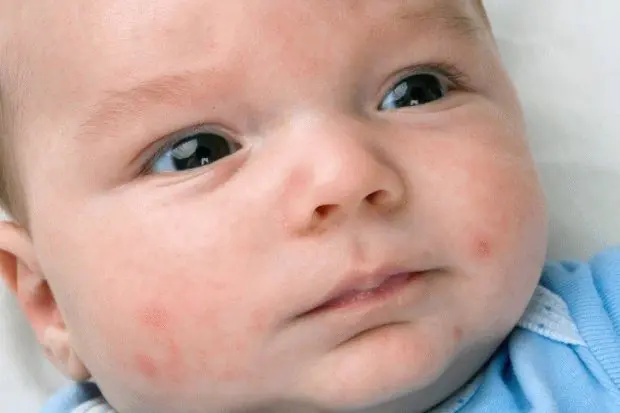
Causes of pimples
White pimples
- Newborn acne
An excess of maternal hormones in the child’s body.
After birth, the child’s body is saturated with maternal hormones, which affect the condition of the skin, because of this, children may develop a rash (ghormonal acne). This phenomenon has a scientific name - neonatal acne. Most often the face area is affected, less often other parts of the body. Acne does not require treatment, the only thing necessary is to keep your skin dry and clean. Acne is not contagious and is not a sign of poor hygiene. The main sign of acne is localization in the face, neck and scalp.
Excessive activity of the sebaceous glands.
Immediately after birth, the glands are activated, which is where pimples appear on the baby’s face. These pimples have the appearance of acne that cover large areas of the skin. The rash usually appears a week after birth and lasts about a month. There is no need to worry if the pimples on the face do not cause discomfort to the newborn baby - they do not itch, do not fester or become inflamed.
What pimples look like - they look like accumulations of pus under the skin of a whitish-yellow color (the base is red, the tip is white).
Video to watch:
- Milia
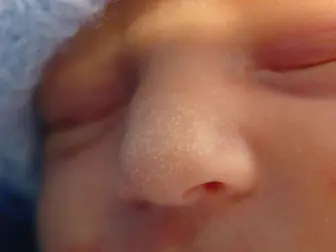
Small white pimples on the face of a newborn (white dots the size of a pinhead) are milia, an accumulation of secretions in the sebaceous glands (blockage of the sebaceous ducts). They go away on their own and cannot be squeezed out. clean with cotton swabs, treat with alcohol solutions, because You can get an infection and thereby cause an inflammatory process.
Red pimples
- Allergy
A common cause of red pimples is an allergic reaction to a product eaten by the mother. (through breast milk, the baby receives not only nutrients, but also allergens. Read about the nutrition of a nursing mother), or the formula that is fed to a newborn. To prevent allergies, a nursing mother should keep a diary in which she will write down everything she has eaten and the time when she ate this or that product. Typically, 18 hours after eating an allergen, pimples may appear on a newborn's cheeks (and sometimes all over the body). In this case, the product is removed, and if the cause of the allergy is the mixture, then it should be replaced with another.
Allergies can also be caused by washing powder that is used to wash your baby’s clothes. Remember that a child’s skin is very delicate, so baby clothes should only be washed with powder or gel that is marked “hypoallergenic.” Allergies can also be caused by animal fur, flowering plants and other external irritants.
The allergy manifests itself in the form of red spots with small rashes and crusts that peel off.
If red spots (pimples) appear on the newborn's face, you should consult a doctor. Allergies require treatment.
Video to watch:
- Prickly heat
Clothes that are too hot, the air temperature in the child’s room is high, excessive "wrapping" - all this leads to the fact that the child begins to sweat. Skin that is constantly in a state of moisture becomes covered with acne. Acne first appears in the neck area, then it can spread to the face. To avoid the appearance of prickly heat, you need to maintain a constant air temperature in the room where the newborn is located - 18 - 22 degrees Celsius. It is advisable to dress the child only in clothes made from natural fabrics, according to the weather, and not to overheat.
- Dysbacteriosis
This is another reason for the appearance of pimples in newborns. Look at the symptoms and causes of dysbiosis.
To treat or not to treat
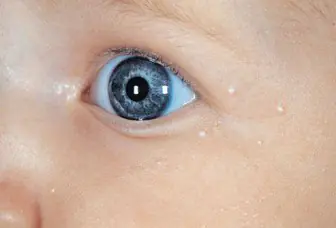
In most cases, the small white pimples (hormonal breakouts) go away on their own, so mom just needs to be patient. By about 2 months, most babies can already boast of soft, smooth skin without any acne.
Never squeeze pimples; this can seriously damage the top layers of the skin, cause infection and leave scars.
All doctors advise that if a rash or pimples appear, you need to consult a specialist; only a specialist can make the correct diagnosis.
Can:
If you still want to alleviate the condition of your baby’s skin, the simplest and most proven method is:
- Wash your child with boiled water 2 - 3 times a day;
- bathe the child in a weak solution of potassium permanganate;
- or bathe your baby in a series (bathing in various herbal decoctions). Sequential baths gently care for baby skin. Before daily bathing, add a brewed series to the bath (a large cup per bath) and bathe the child as usual;
- wipe the face and affected areas of the skin with a decoction of string or chamomile;
- It is necessary to ensure proper skin care (link to article below).
It is forbidden:
Do not use fucorcin, potassium permanganate or brilliant green for treatment, do not use alcohol-containing lotions or solutions, as these products will not cure acne and can only harm the baby’s health. No need to use: fatty oils and ointments, powder, calendula tincture, hormonal ointments, lactic acid bacteria or adsorbents (smecta), antibiotics, antihistamines. We repeat - squeezing pimples is prohibited!
Prevention
Most pimples in newborns are not considered dangerous and by following simple rules you can prevent their occurrence:
- A nursing mother should monitor her diet (what not to eat);
- For IV, monitor the reaction to the mixture;
- Proper hygiene and child care is necessary;
- Give your child air baths;
- Wash baby clothes with special powders.
If any acne or rash appears, you should immediately consult a doctor. The diagnosis should only be made by a specialist. There are a huge number of varieties of rashes that only a doctor can recognize.
Often, for severe and long-lasting acne, doctors prescribe medications such as Panthenol, Bepanten, Zinc ointment.
On the topic of skin problems:
Video: acne / allergies
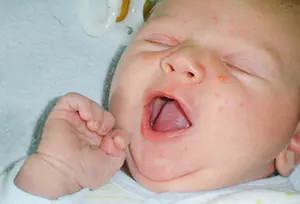
The first three months of a child’s life cannot be without rashes. Small pimples appear on the nose, face or forehead, and the reason is not inflammation at all, but the formation of hormonal levels. This phenomenon is associated with a large release of maternal estrogen hormones into the baby’s blood. Sometimes these rashes may not be visible because they are located under the skin. But it is worth knowing that a child can have other types of rashes and acne.
Causes of pimples on a baby's face
The appearance of a rash on the face of a newborn is provoked by various reasons, and depending on them the right treatment is selected.
- Allergic reaction to mother's food. Along with breast milk, not only useful substances enter the baby’s body, but also allergens that the young mother consumes. A very strong allergen for a child is cow's milk, as well as red-colored foods - tomatoes, apples, watermelon. A breastfeeding woman should be very careful about her diet.
- As already mentioned, hormonal rashes appear on the child’s face. They can also be seen on the back or neck. Such pimples should not be touched; after a while they will disappear without a trace.
- Prickly heat. A rash of this kind can occur due to severe overheating of the baby. First it can be seen on the neck, then in the area of the nasolabial fold, ears.
- Poor quality diapers, detergents and wet wipes can cause rashes. The same can be said about washing powder. Therefore, it is necessary to use only special hypoallergenic products.
- The child should always be clean and dry. With improper care, irritation appears in the form of small red blisters and pimples.
- Milia. The accumulation of secretion from the sebaceous glands provokes small pimples with white accumulations inside. They go away on their own and should not be touched. With any invasion, inflammation may occur.
Types of rashes
To determine the types of acne on a baby’s face, you need to take a close look at them and determine what acts as a provocateur. You can also find photos on the Internet and focus on them. Only a doctor can make an accurate diagnosis, but every mother can recognize the most common types of pimples.
Most often, this problem can be diagnosed at 2-3 weeks of a baby’s life. Reddish pustular pimples appear on the cheeks. The main reason is hormonal changes in the child’s body. This disease is absolutely safe and goes away within 2–4 months of the baby’s life.
Diathesis
Pinkish rashes cause stomach upset and allergic reactions to external irritants. Pimples can be seen not only on the face, but throughout the body. The main cause of the disease is washing powder, powder, cream, type of fabric. To establish an accurate diagnosis and prescribe treatment procedures, it is necessary to visit a pediatrician.
Ritter's disease
Very often you can see near the baby's mouth whitish bubbles, which very quickly move to other parts of the body and face. After this, the pimples burst and the skin begins to peel off. This disease is of an allergic and infectious nature. The problem can only be treated under the strict supervision of a doctor.
Seborrheic dermatitis
The disease is characterized by scaling and peeling of the skin on the ears. Experts say that the main reason is hormonal imbalances in the body and the development of yeast fungi. The disease goes away on its own in 2-4 weeks, but consultation with a pediatrician is required.
Infectious diseases with rash in a child
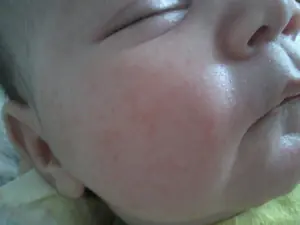
Many infectious diseases are accompanied by rashes on the body, which appear not only after birth, but also occur in older children. Scarlet fever is one of these unpleasant diseases. During illness, red pimples appear on the baby’s skin, the temperature rises, the skin on the hands and feet peels, and the throat and tongue take on a crimson color.
Another disease is measles. The disease is characterized by the appearance of rashes every day on certain parts of the newborn’s body. First, neoplasms can be seen on the face and neck, then the infection affects the shoulders and torso, and finally the arms and legs.
At first the rashes are red, and after a few days they darken and peel. All this leads to severe itching, restless sleep and behavior of the baby.
Chickenpox rashes affect not only the child’s face and body, but also the hair. At first, the pimple is red in color, then fills with clear or pustular fluid. Usually the disease is accompanied by high fever, gastrointestinal upset and inflammation of the respiratory tract. During this period of illness you can't bathe a child, because any contact with water will worsen the condition.
The most dangerous disease is meningitis with a large number of acne on the body of a newborn. There can be so many affected areas of the body that they merge with each other into large inflamed foci. The disease occurs with high fever, inflammation of the meninges and a general serious condition.
If rashes are found on the child’s face, you should not self-medicate; you should visit a pediatrician for consultation.
Is it worth treating rashes in a child?
Most types of rashes in infants pass on their own, the main thing is to be patient. Most babies already have smooth and clear skin at 2-3 months. Any doctor and experienced mother will tell you that if acne appears on the face of a newborn, you should immediately run to the doctor for diagnosis.
General treatment tips:
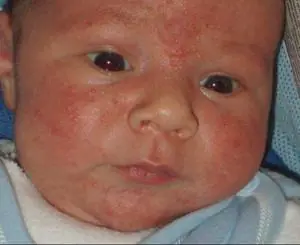
A newborn should be bathed in decoctions of string, sage or chamomile. You can wash your child with this liquid in the morning and evening.- Moisturize your facial skin every day with special hypoallergenic creams.
- A very weak solution of potassium permanganate is also perfect for bathing.
- The room should be ventilated every day and monitor the correct temperature. It should be 18-21 0 C.
- Nails must be cut constantly, as the baby scratches itself and can become infected.
- Use special children's products to wash linen and clothes.
What not to do?
Many mothers, when the first pimple appears, begin to treat the skin of their newborn - smear with creams, alcohol tinctures, and even worse, they try to squeeze out the tumor. All these manipulations will lead to the formation of a new rash and infection of the affected skin.
For treatment, you cannot use lotions and creams that contain alcohol, which dries out the baby’s delicate skin. But a very greasy cream is also bad. A fatty environment is an excellent place for bacteria to grow.
Under no circumstances should you, without a doctor’s prescription, give your child antibiotics or apply medicinal ointments and creams.
Prevention
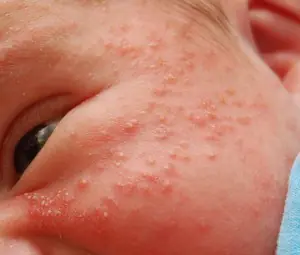
Every day the child’s face should be washed with boiled water.- A nursing mother should exclude allergenic foods from her diet. If, after following a strict diet, the baby’s rashes do not stop, you should visit an allergist or pediatrician.
- The longer you have the opportunity to bathe your child in a decoction of herbs, the better. Any shampoos and detergents are the cause of most cases of rash in a baby. This includes washing powders.
There is not a single child in the world who does not have a rash on their face at least once in their life. In this case Don’t panic and invent illnesses. At birth, the baby has no immunity; it develops gradually. Therefore, a weak system always reacts violently to a new environment, substances, food. But it is worth knowing that even if the rash looks like ordinary heat rash, for peace of mind it is better to consult your pediatrician.
In most cases, acne on the cheeks in children is only a symptom of a specific disease. Acne in newborns is characterized by rapid resolution and moderate severity. Acne that occurs in children over one year of age occurs due to hormonal imbalance and hyperfunction of the sebaceous glands. In order to quickly and effectively get rid of acne, you need to seek help from a dermatologist.
Types of acne on cheeks
There are many classifications of acne. Acne in children is completely different from acne in adults. Next, we’ll tell you about the types of acne on the cheeks in childhood:
Acne of newborns.
Estrogenic acne occurs as a result of the influence of maternal hormones on the child's body. An excess of female sex hormones disrupts the normal functioning of the sebaceous glands. Neonatal acne occurs in a quarter of children in the first days of life. At the site of blockage of the sebaceous glands, whitish papules with a pearlescent tint are formed. The rash is localized on the cheeks, nose and genitals. In boys, estrogenic acne is more severe than in girls. A distinctive feature of newborn acne is the tendency to group the formed elements of acne. They are represented by closed comedones, papules, pustules and, in rare cases, nodules. This condition does not require special drug treatment. Acne acne goes away in the first three months of life, but sometimes this process can drag on for up to a year.
Baby acne
Unlike newborn acne, this type of rash occurs much later, at about 3-6 months of life. Their appearance is associated with an increase in the level of testosterone (male sex hormone) in the blood plasma. Hormonal disruption occurs due to temporary gonadotropic activation. Baby acne can last up to 4 years. If acne occurs in newborns, it is necessary to seek help from a pediatric dermatologist in order to exclude serious congenital diseases. Hyperplasia and tumor-like formations of the adrenal glands can masquerade as infant acne, so the occurrence of acne requires a thorough examination of the child. Infant acne often develops severe acne. Purulent cysts may appear followed by scarring. Acne is represented by open and closed pustules. Baby acne usually goes away by age two, but there are cases where acne can last up to 5 years. Acne can be complicated by spherical or conglobate acne. This form of the disease can lead to the development of severe acne during puberty.
Acne in early childhood
In very rare cases, acne occurs over the age of one year and up to seven years; they are also called preschool acne. When acne appears in early childhood, you should pay attention to the level of neurophysical development. In some cases, preschool acne may only be a symptom of androgen-producing tumors or adrenal neoplasms.
Prepubertal acne
Occurs in the age range from 7 to 12 years. Prepubertal acne is characterized by the appearance of open and closed comedomas on the face. In very rare cases, papules and pustules may occur. The appearance of these rash elements may indicate the presence of an endocrine disease. For example, polycystic ovary syndrome. If a girl develops acne before her first period appears, then she should seek help from an endocrinologist.
Juvenile acne
Occurs in boys and girls aged 12 to 16 years. Acne on the skin of the face appears in the form of typical acne lesions. However, juvenile acne is significantly different from adult acne, which occurs due to hormonal imbalance. During puberty, acne usually consists of papules and pustules, and to a lesser extent comedones.
Reasons for appearance
Rashes in the cheek area in children can occur for a variety of reasons. It is necessary to differentiate the pathological process from other dermatoses that can occur due to viral, fungal and bacterial diseases.
Acne of newborns occurs against the background of a sexual crisis, when a huge amount of maternal hormones enters the child’s body. Infant acne can occur due to poor diet by the mother. An allergic reaction to hygiene products (shampoo, soap, powder), indoor plants and animals is possible. All young children have not fully developed sebaceous and sweat glands. In addition, the newborn’s body has an immature thermoregulatory system. A sharp change in air temperature can trigger acne. Do not forget about infectious diseases, which manifest themselves in multiple rashes not only on the cheeks and throughout the body. You can suspect something wrong by an increase in body temperature and the presence of signs of a cold (runny nose, cough).
In adolescence, acne occurs due to a hormonal surge and poor personal hygiene. In order to avoid problems in the future, you need to visit a cosmetologist with your child, who will help you choose facial skin care products and teach them how to use them.
Diagnostics
If a child begins to develop acne between the ages of 1 and 12, you should consult a dermatologist. In order to assess the general condition of the body, the doctor prescribes routine tests, such as a clinical blood test and urine test. Metabolic processes can be assessed using a biochemical blood test. The occurrence of acne in this age range may indicate the development of a serious disease, where acne is only a symptom. The real reason may be inside the body. An imbalance of hormones leads to acne, so you need to seek help from an endocrinologist.
Acne in early childhood can cause hyperandrogenism. This disease manifests itself at early puberty. Boys develop body odor very early. Girls develop male pattern hair and develop a deep voice. To exclude the diagnosis of hyperandrogenemia, a study is prescribed to determine the levels of testosterone, follicle-stimulating and luteinizing hormone.
In addition to laboratory research methods, instrumental research methods are prescribed. Ultrasound diagnostics of the pelvic organs, kidneys and adrenal glands is carried out. If a malfunction of the hypothalamic-pituitary system is suspected, magnetic resonance imaging is recommended.
Drug therapy
The treatment of acne in childhood must be approached with the utmost seriousness. In addition to mental problems, acne can lead to serious pathological processes in the body. Self-medication is strictly prohibited. In a child’s body, all processes occur much faster than in an adult. Thus, small ulcers can quickly develop into a powerful inflammatory process. In addition, children's skin is significantly different from adult skin. Normally, a healthy child should not develop acne if the rules of personal hygiene are observed. When acne occurs, it is necessary to identify the root cause of the disease and eliminate the underlying disease. Next, we will discuss how acne is treated depending on age periods:
Treatment of acne in newborns.
Estrogenic acne is characterized by a sudden appearance and rapid disappearance. They usually do not require special treatment. If multiple foci of acne appear, topical application of ketoconazole-based ointment is prescribed. The use of this substance will significantly reduce the period of rashes. If inflammation appears around the acne elements, they can be treated with a solution of aniline dye, such as blue or brilliant green.
Treatment of acne in infants and young children
The treatment for these types of acne is no different. Treatment of the severity of acne is treated with local preparations based on retinoids, benzyl peroxide and broad-spectrum antibacterial drugs. In very rare cases, antibiotics are prescribed in tablet form. An indication for antibiotics may be the appearance of deep nodes and papules that do not go away within 30 days. In this case, the drug of choice is erythromycin. If an allergic reaction occurs to the medicine, use sulfamethoxosil. For deep lesions of the skin of the cheeks, injections of triamcinolone acetonide or isotretinoin are indicated. The duration of treatment ranges from 6 to 12 months.
Treatment of juvenile acne.
Treatment of acne in adolescence is carried out taking into account the form, location and concomitant diseases, if any. Topical comedolytics are more effective in the treatment of acne. This group includes drugs based on salicylic acid, retinoids, benzyl peroxide and retinoids. It should be noted that the use of scrubs and rough cosmetic procedures is contraindicated.
In the acute inflammatory period, the use of local antibacterial cosmetic products that contain benzoyl peroxide is indicated. Systemic antibiotic therapy is indicated in severe cases when local treatment is not effective. Dermatologists prescribe erythromycin, ampicillin or sulfamethoxazole. If a child develops nodular cystic and conglobate elements of acne on the facial skin, it is better to use isotretinoin. Its use reduces the risk of scarring.
When treating juvenile acne, you should pay special attention to hormonal levels. Severe and resistant forms of acne are treated with hormonal drugs, such as glucocorticosteroids and antiandrogens.
Procedures and traditional methods of treatment
It is prohibited to carry out cosmetic procedures to eliminate acne before reaching adulthood. It is necessary to treat traditional medicine with great caution. Alternative methods of treating acne can lead to irreparable harm to the child's health. Children are more susceptible to developing an allergic reaction than adults. It is allowed to wipe the face with decoctions of herbs that have antiseptic properties (chamomile, chamomile, calendula).
Prevention
When pimples appear, do not squeeze them. The child's face must be kept clean. Using all kinds of creams and oils can cause acne. Mothers of breastfed children must adhere to a special diet.
Conclusion
Acne is quite common in children. It is necessary to take very seriously the occurrence of acne at an atypical age (from 12 months to 8 years). If you experience prolonged or recurring acne, you should consult a dermatologist and related specialists. A quick diagnosis and timely treatment can prevent the formation of cosmetic defects and avoid psychological trauma to the child.




